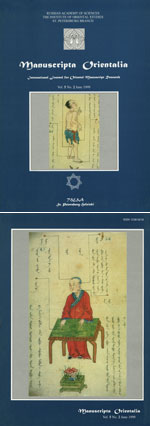|
|
| |

|

|
Kulganek I. A Mongolian Folk Songs Collection in the St. Petersburg Branch of the Institute of Oriental Studies // Manuscripta Orientalia. Vol. 5. No. 2. June 1999. P. 18—26.
Folks songs are extremely popular among the Mongols, representing their best loved musical-poetic genre. They created a vast corpus of songs, with text or without it, which could be sung, whistled, recited, performed by choir and solo in various styles: homiyloh (lit., singing with the throat), haylah (lit., crying), dongildoh (lit., ring). These songs arose on the basis of a much earlier inheritance: calls, exclamations, and sound imitations used to call up animal's young, cheer up hunters or lure animals into traps. Folklore texts took up an important place in Mongolian literature. To cite only one example, one third of the first written text of Mongolian literature, the thirteenth-century Yuan-Chao-Bi-Shi (Sacred Story), includes numerous folk songs, fables, and legends. Yuan-Chao-Bi-Shi contains a fragment which indicates the syncretic nature of the ancient song genre; the song is an integral part of festivities. We read, for example: “They gathered in Horhon Chjubun khan's land, there was marry-making, with feasting and dancing. Having elevated Hutula to the khan's throne, they danced around the branchy tree at Horohonah. They danced so that, as they say, pot-holes formed up to their hips and heaps of dust — up to their knees”.
Through centuries songs accompanied all of the Mongols’ celebrations, be they related to the calendar rites, religious rituals, or shaman practices. Songs were included in the medieval Mongolian historical chronicles like Erdeniyn erih (Precious Rosary) and Altan tobch (Golden History). The arats wrote them down in collections and kept them as most valuable treasures. At present, we know 18 manuscript folk songs collections held at the Mongolian Institute of Language and Literature. Folklorists, who study Mongolian folk songs, hesitate over saying exactly when the tradition of drawing up song collections began. Our own observations on the manuscript collections of Mongolian songs held at the St. Petersburg Branch of the Institute of Oriental Studies lead us to conclude that the tradition arose no earlier than the eighteenth century...
К содержанию выпуска...
 PDF-файлы PDF-файлы
Полный текст статьи
Ключевые слова
песни монгольские
фольклор монгольский
|
|
|
|
|

